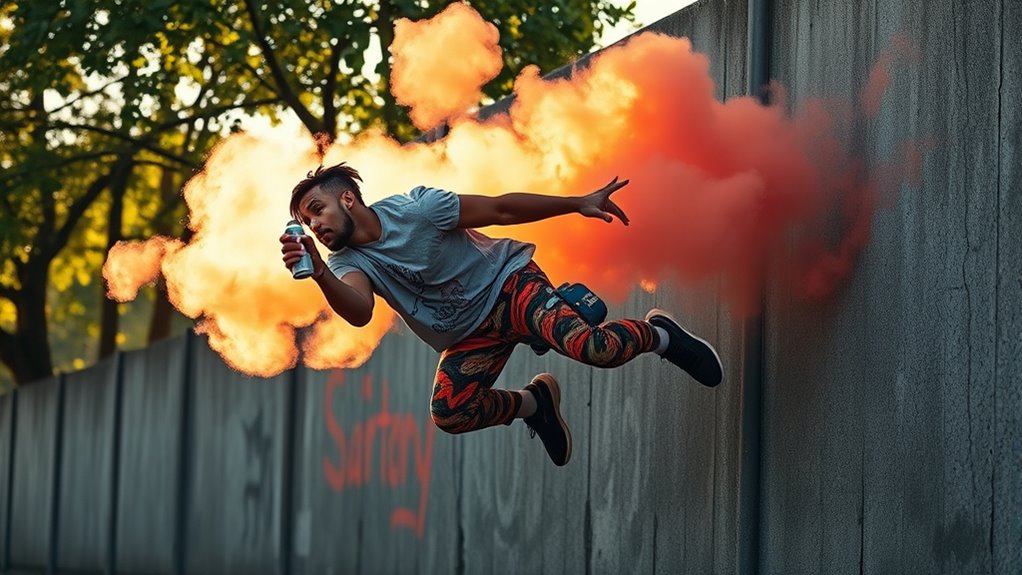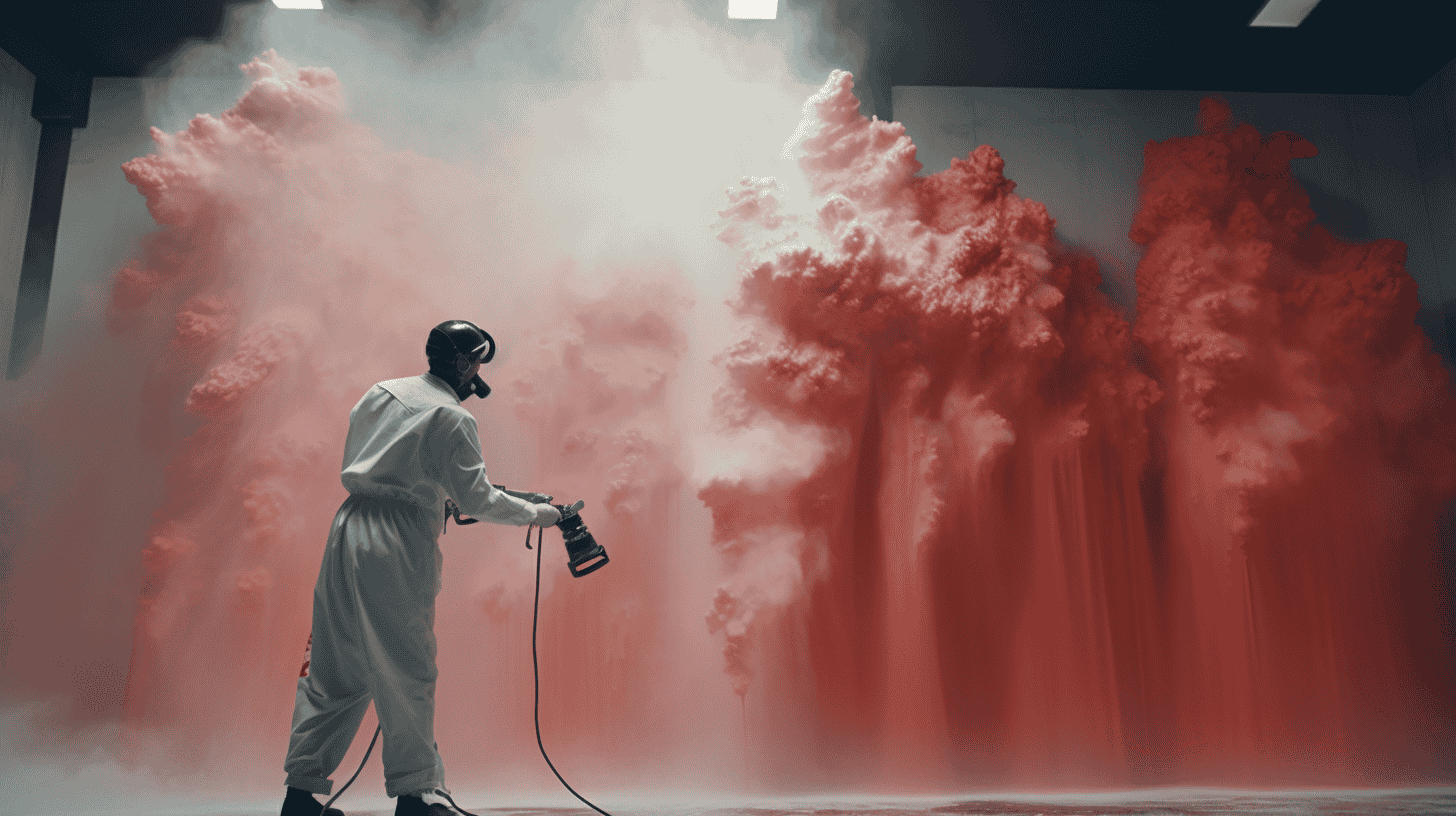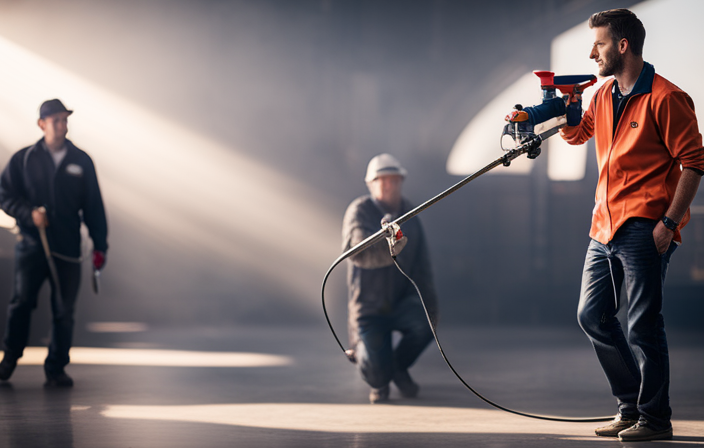Backrolling after spraying is needed when you notice uneven textures, thin spots, or spray pattern issues that affect the finish’s durability and appearance. It helps embed paint deeper into surfaces, improves adhesion, and creates a smooth, uniform look. If your spray results look rough or streaky, backrolling is the solution. Continuing with this process guarantees your project achieves a professional, long-lasting finish—so keep going to learn how to do it right.
Key Takeaways
- Backrolling helps fix uneven spray patterns and surface imperfections for a smoother, more durable finish.
- It is recommended when spray coverage is inconsistent or streaky, especially on textured surfaces.
- Backrolling improves paint adhesion by embedding paint deeper into surfaces, enhancing durability.
- Performing backrolling immediately after spraying ensures better blending and a uniform appearance.
- Proper surface prep and technique are essential to maximize the benefits of backrolling and prevent issues.
Understanding the Purpose of Backrolling
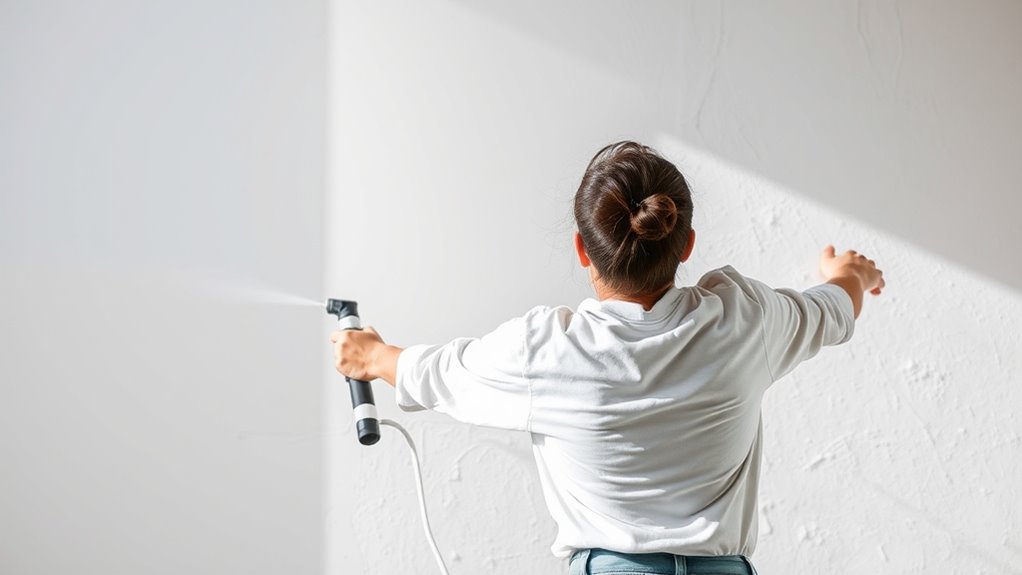
Backrolling serves a essential role in ensuring a smooth and durable spray finish. When you spray paint using a spray gun, you might notice uneven textures or thin spots. Backrolling addresses these issues by applying a paint roller over the sprayed surface. This process helps to embed the paint deeper into the surface, ensuring better adhesion and a more uniform appearance. It also reduces the risk of drips, runs, and spray patterns that can mar the finish. By blending the spray and roller techniques, you achieve a consistent coat that lasts longer. Backrolling is especially useful on textured or porous surfaces, where spray alone might not provide complete coverage. Additionally, the technique can help improve paint adhesion on challenging surfaces. Overall, it’s a critical step to enhance durability and achieve professional-looking results.
When to Consider Backrolling in Your Spraying Project
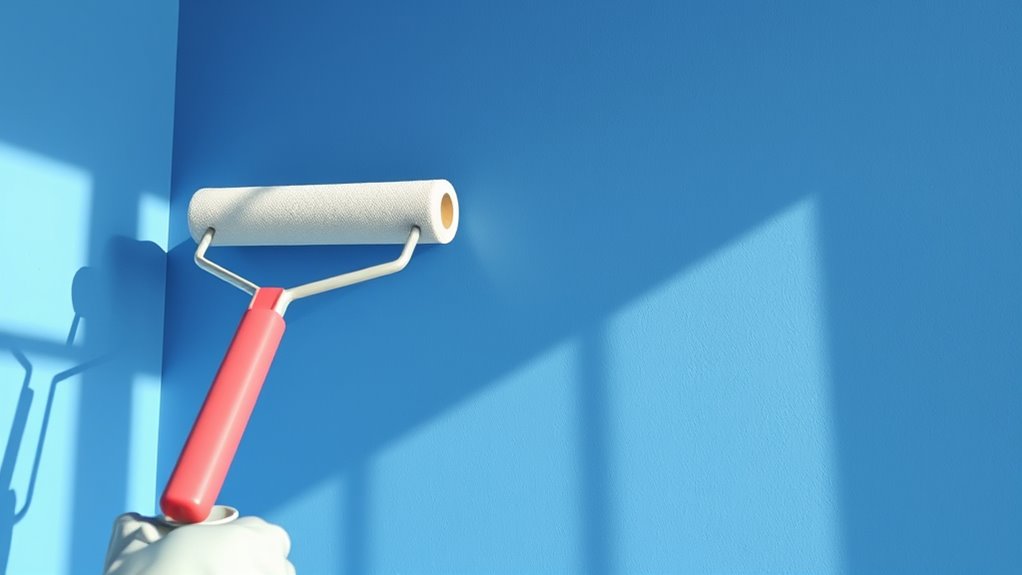
You should consider backrolling when you’re concerned about surface uniformity or want to fix uneven spray patterns. If you’re facing adhesion issues or need to make certain of complete coverage, backrolling can help achieve a smoother, more consistent finish. Recognizing these signs will help you decide the right moment to add backrolling to your project. Additionally, understanding the role of paint application techniques can further improve your results by ensuring optimal coverage and surface quality.
Surface Uniformity Concerns
Surface uniformity is crucial for achieving a professional finish, and noticing inconsistencies during spraying should prompt closer inspection. If your color matching looks uneven or streaky, it’s a sign you might need to backroll. Uneven application can also be caused by equipment maintenance issues, such as clogged nozzles or inconsistent pressure, which affect spray pattern and thickness. Addressing these concerns early helps ensure a smooth, uniform coating. Consider backrolling when:
- The spray pattern appears inconsistent or uneven
- Colors don’t match seamlessly across surfaces
- Equipment needs maintenance or calibration to improve spray quality
Backrolling helps blend these imperfections, ensuring a consistent, professional-looking finish. Recognizing surface uniformity concerns early saves time and prevents costly rework later on. Regularly inspecting and maintaining your sprayer’s nozzles and pressure settings can also help maintain consistent spray quality.
Overcoming Paint Adhesion Issues
When paint fails to adhere properly to a surface, it often indicates underlying issues that need addressing before proceeding. Poor adhesion can cause uneven paint texture, leading to peeling or bubbling over time. If you notice the paint isn’t sticking well, consider backrolling to improve adhesion and smooth out the surface. This technique helps embed the paint into porous surfaces and ensures better durability. Additionally, if color matching appears inconsistent or streaky, backrolling can help blend layers more evenly. Recognizing these signs early prevents wasted effort and costly rework. You should consider backrolling when adhesion problems arise, especially on textured or uneven surfaces, to achieve a uniform finish and long-lasting results. Properly addressing adhesion issues ensures your project looks professional and withstands the test of time. Using an airless paint sprayer can also help provide an even application that minimizes these problems from the start.
Ensuring Complete Coverage
After addressing adhesion issues, attention shifts to achieving complete coverage for a uniform finish. This is when backrolling becomes essential, especially if spray patterns leave thin spots or uneven areas. To ensure thorough coverage, focus on proper brush techniques and monitor drying times carefully. If you notice streaks or missed spots after spraying, backrolling can help blend the paint seamlessly. It’s also important to work within the recommended drying times to prevent streaking or peeling. When spraying large surfaces, consider backrolling if you see uneven patches or if the spray pattern isn’t uniform. This extra step guarantees a smooth, consistent finish and reduces the need for future touch-ups. Recognizing when to backroll saves time and improves the overall quality of your project. Additionally, understanding paint application techniques can help you determine the best moments to employ backrolling for optimal results.
Benefits of Backrolling for Better Coverage
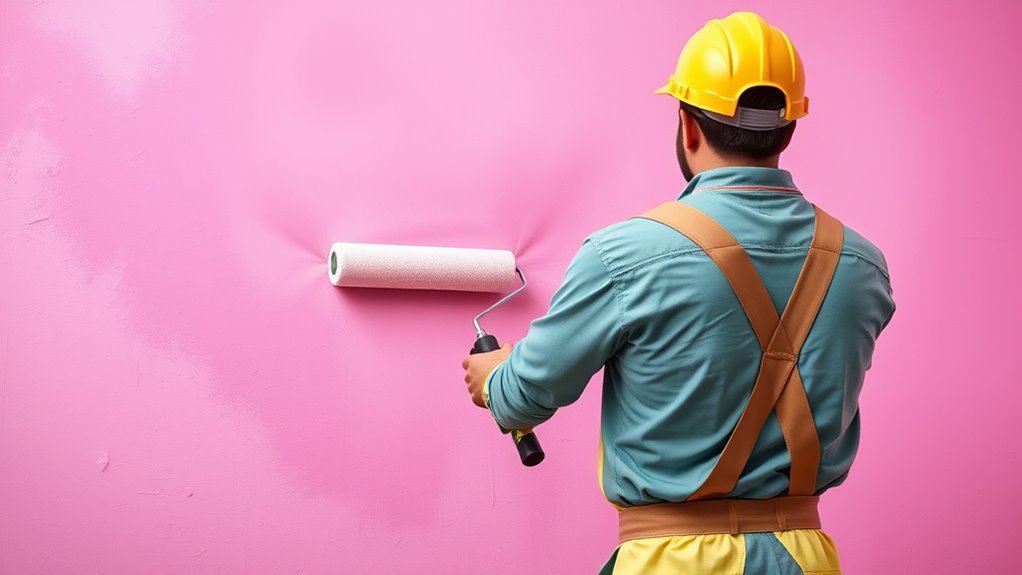
Backrolling helps your paint go on more evenly, giving you a smoother, more professional finish. It also reduces the chances of drips and sags that can ruin your project’s look. By incorporating backrolling, you’ll achieve better coverage with less hassle. Additionally, understanding proper painting techniques can further enhance your results and ensure a long-lasting finish.
Enhances Paint Uniformity
Backrolling considerably improves paint uniformity by helping the coating settle evenly across the surface. It smooths out brush techniques and spray patterns, reducing streaks and uneven patches. This method ensures that the paint layers blend seamlessly, leading to a more consistent finish. By applying gentle pressure, you promote better adhesion and help the paint fill in gaps, which minimizes the risk of visible inconsistencies. Proper backrolling also influences drying times because a smoother surface dries evenly, preventing streaks or blotches. To maximize benefits, focus on maintaining steady, overlapping strokes and avoid overworking the area. Remember, the goal is to create a uniform coat that looks professional and lasts longer. Using the right techniques can enhance the overall decorative appeal and durability of your paint job. With consistent backrolling, you’ll achieve a flawless, even finish every time.
Reduces Drips and Sags
When you incorporate backrolling into your painting process, you considerably reduce the likelihood of drips and sags forming on the surface. This technique helps distribute paint more evenly, minimizing uneven buildup that causes drips. Proper surface preparation ensures the surface is clean and smooth, making backrolling even more effective. As the paint begins to cure, excess paint can sag if not properly worked into the surface. Backrolling helps blend these areas, preventing visible drips or sags after drying. It also promotes better adhesion, reducing the chances of imperfections. By actively working the paint into the surface, you achieve a more uniform finish and avoid the need for additional touch-ups. Additionally, understanding self watering plant pots can be a useful analogy for how even distribution of moisture or paint leads to healthier, more consistent results. Overall, backrolling is essential for smoother coverage and a professional-looking result.
Enhancing Adhesion With Backrolling
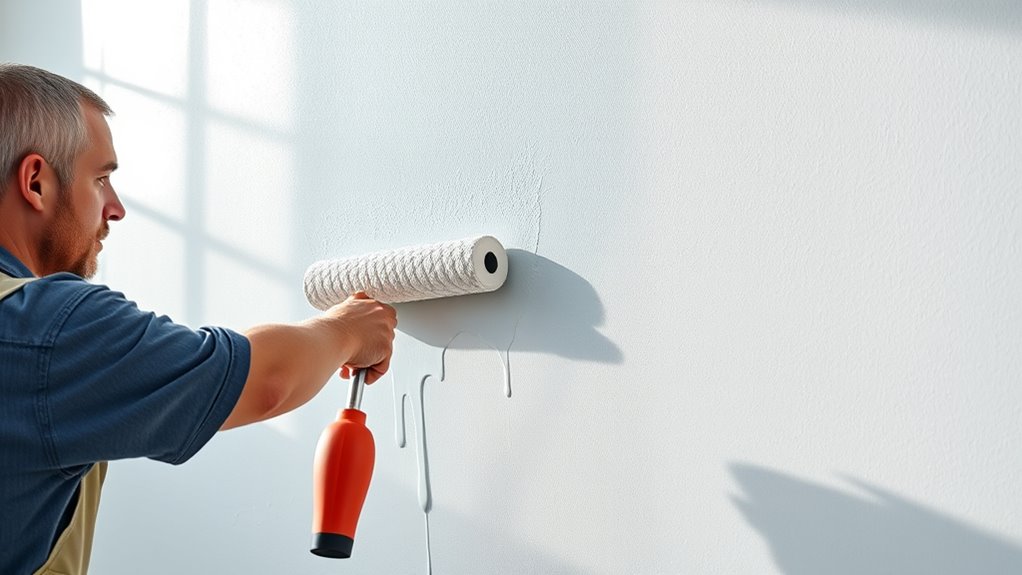
To guarantee the spray coating adheres properly to the surface, backrolling is a critical step that helps improve overall adhesion. It ensures the paint penetrates the surface for a stronger bond. Before backrolling, make sure your paint is well mixed; proper paint mixing is essential for consistent application. Also, verify your spray gun calibration to deliver the right amount of paint evenly. As you backroll, focus on applying steady pressure to create uniform coverage. This process helps embed the coating into porous surfaces and reduces the risk of peeling later. Keep these tips in mind:
Backrolling ensures strong adhesion and a durable finish with steady pressure and proper technique.
- Use consistent, even strokes during backrolling
- Maintain correct spray gun settings for ideal spray pattern
- Adjust your paint mixing to prevent clumps or separation
- Ensuring proper surface preparation is vital for optimal adhesion and durability
Following these steps maximizes adhesion and results in a durable, high-quality finish.
Reducing Residue and Improving Finish
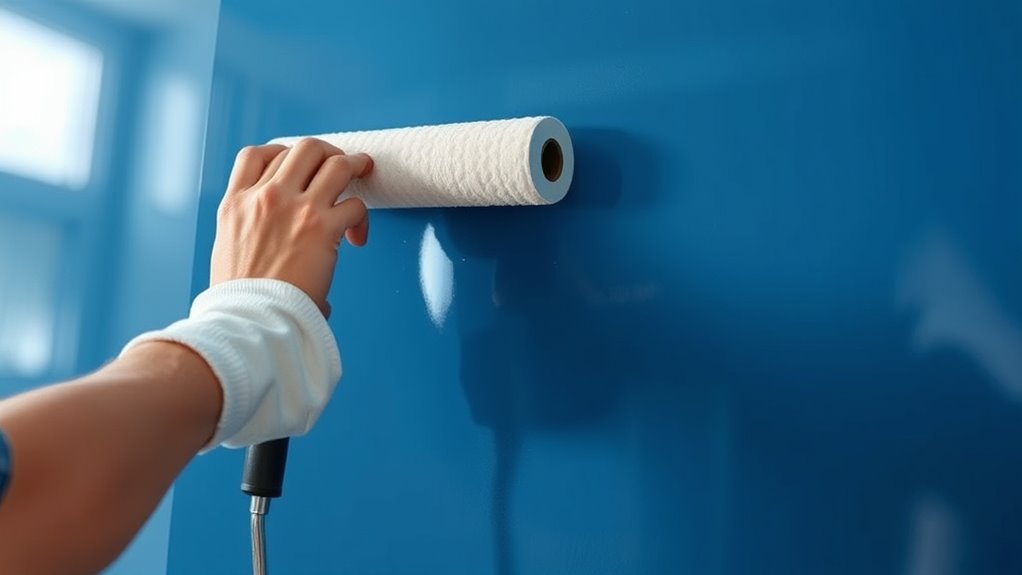
To achieve a cleaner finish, focus on residue minimization techniques like proper spray distance and controlled application. Using the right tools and techniques can also enhance surface smoothness, reducing imperfections. These steps help you get a more professional look with less cleanup afterward. Additionally, understanding the tuning process can ensure that the applied coatings are compatible with your vehicle’s modifications, leading to a more seamless finish.
Residue Minimization Techniques
Achieving a clean finish after spraying hinges on effectively minimizing residue. Residue can affect your paint texture and hinder accurate color matching. To reduce residue, start by adjusting spray equipment for optimal atomization, ensuring even coverage without over-spraying. Use high-quality primers and sealers to create a smooth base, which helps prevent unwanted buildup. Additionally, proper surface preparation—cleaning and sanding—removes contaminants that can cause uneven finish or residue. Properly maintaining your spray equipment also plays a vital role in preventing equipment malfunction, which can lead to excess residue and inconsistent coverage.
- Fine-tune spray pressure and nozzle settings
- Select compatible paints and primers for better adhesion
- Maintain consistent spray distance and movement
These techniques help you control residue, resulting in a smoother, more professional finish that aligns with your desired paint texture and color accuracy.
Enhancing Surface Smoothness
Enhancing surface smoothness begins with meticulous surface preparation; cleaning and sanding remove dirt, grease, and imperfections that can trap residue or cause uneven finishes. Proper surface preparation guarantees that paint adheres uniformly, reducing the need for excessive backrolling later. When aiming for color matching, a smooth surface helps achieve a consistent, professional appearance, minimizing visible flaws. After prepping, inspect the surface for remaining rough spots or debris, and smooth them out. This process minimizes residue buildup and creates a uniform foundation for spraying. A well-prepared surface not only enhances finish quality but also reduces the need for additional layers or touch-ups. Additionally, considering surface texture can further improve the overall paint application and finish durability. By prioritizing thorough surface preparation, you set the stage for a sleek, even paint job with minimal residue and ideal color matching.
Situations Where Backrolling Is Essential

Backrolling becomes essential when you’re working with certain surfaces or finishes that are prone to uneven paint coverage or streaking. If the initial spray leaves inconsistent layers or visible lines, backrolling helps smooth out the surface. This process also guarantees better adhesion and a uniform appearance, especially when dealing with complex paint colors or subtle shades. Proper brush techniques during backrolling help blend transitions seamlessly, preventing color inconsistencies. You’ll find backrolling particularly useful in areas with textured surfaces or uneven drywall. Additionally, understanding how paint properties influence finish quality can guide you in choosing the right technique for optimal results.
Selecting the Right Tools and Techniques for Backrolling

Choosing the right tools and techniques for backrolling can make a significant difference in achieving a smooth, professional finish. The key is selecting the appropriate roller and mastering effective brush techniques. A high-quality roller with the right nap length guarantees even coverage and reduces streaks. For detailed areas, use a brush with firm bristles to blend edges seamlessly. Consider this table for guidance:
| Tool | Technique | Purpose |
|---|---|---|
| Short-nap roller | Light, consistent pressure | Smooth, flat surfaces |
| Long-nap roller | Slow, overlapping strokes | Textured or uneven surfaces |
| Angled brush | Gentle feathering | Edges and corners |
Choosing the right combination assures your backrolling is efficient and flawless, preventing issues down the line. Proper technique and tool selection will enhance the overall quality of your paint job.
Common Mistakes to Avoid When Backrolling

Even experienced painters can make common mistakes when backrolling that compromise the quality of the finish. One mistake is neglecting proper surface preparation, which can cause uneven absorption and paint failure. Another is rushing the paint color selection; choosing incompatible or overly bright colors without testing can lead to dissatisfaction. Additionally, failing to maintain consistent pressure and technique during backrolling can create streaks or texture issues. Incorporating creative problem-solving can help address unexpected challenges during the painting process. To avoid these errors: – Always guarantee thorough surface preparation before backrolling. – Take your time with paint color selection and test samples first. – Keep a steady hand and consistent pressure during backrolling to achieve an even coat.
Comparing Backrolling With Alternative Methods

While backrolling is a popular technique for guaranteeing a smooth, even finish, there are other methods you might consider depending on your project’s needs. Brushing or rolling directly can sometimes save time, but they might not achieve the same paint durability or color consistency as backrolling. Spraying alone can produce a uniform coat, but without backrolling, you risk uneven textures or missed spots. Backrolling helps smooth out spray marks, improve paint adhesion, and ensure consistent coverage. If you prioritize long-lasting results with minimal imperfections, backrolling often outperforms alternatives. Additionally, understanding Halloween-related crafts and activities can inspire creative finishing touches for seasonal projects. However, for small areas or quick touch-ups, brushing or rolling might suffice. Ultimately, choosing the right method depends on your desired finish, project size, and the level of durability you require.
Tips for Efficient and Effective Backrolling

To achieve the best results with backrolling, preparation is key. Start by ensuring your paint is properly mixed to avoid uneven coverage. Use consistent brush techniques to smooth out edges before backrolling, which helps prevent streaks. When backrolling, work in manageable sections, maintaining a wet edge for seamless blending. Keep your roller slightly loaded with paint, but not dripping, to avoid drips and over-application. Regularly check your paint mix to maintain the right consistency and prevent dry spots. Additionally, understanding exfoliation benefits can help you select the appropriate products for your skincare routine.
Frequently Asked Questions
Can Backrolling Damage the Painted Surface?
You might wonder if backrolling can damage your painted surface. When done correctly, it generally doesn’t harm paint adhesion or surface preparation. However, if you press too hard or use the wrong tools, it could cause uneven paint or disturb the finish. To avoid this, make certain proper surface preparation and gentle backrolling. Proper technique helps improve paint adhesion and smoothens the surface without risking damage.
How Long Should I Wait Before Backrolling After Spraying?
Think of your freshly sprayed surface as a delicate canvas waiting to be sealed. You should wait about 10-15 minutes, allowing the paint to set just enough for better adhesion without risking damage. This pause lets the surface settle, ensuring paint adhesion improves through proper surface preparation. Rushing in too soon can disturb the paint, so patience guarantees a smooth, durable finish that lasts.
Is Backrolling Necessary for All Types of Paint?
You might wonder if backrolling is necessary for all types of paint. It isn’t always required, but it can improve paint adhesion, especially on textured or porous surfaces. Proper surface preparation is key, and backrolling helps guarantee an even coat and better adhesion by pushing paint into surface imperfections. For smooth surfaces and high-quality paints, backrolling may be optional, but it’s often recommended to achieve a consistent, durable finish.
What Are the Best Tools for Backrolling on Textured Surfaces?
Imagine giving your textured walls a gentle hug—that’s what the right tools do for texture enhancement. For uneven surfaces, select tools like textured rollers, high-nap rollers, or paint pads designed for rough finishes. These tools help to evenly distribute paint and fill in gaps, ensuring a smooth, professional look. Your choice of tool makes all the difference in achieving a flawless finish on textured surfaces.
How Does Backrolling Affect Drying Time?
Backrolling can slightly extend drying time because it redistributes paint, ensuring better coverage and consistency, especially on textured surfaces. When you backroll, you often work with a slightly thicker or more uniform paint layer, which may take longer to dry. However, this extra drying time is beneficial, as it helps prevent uneven finishes and reduces the risk of peeling or cracking later. Keep in mind, using proper paint consistency also influences drying speed.
Conclusion
Think of backrolling as the finishing brushstroke on a painting—it transforms a good job into a masterpiece. When you backroll at the right moments, you guarantee even coverage, better adhesion, and a smoother finish. Skipping or rushing this step is like leaving stray brushstrokes—your project won’t look as polished. So, take your time, use the right tools, and backroll with purpose. It’s the secret to achieving a flawless, professional look every time.
